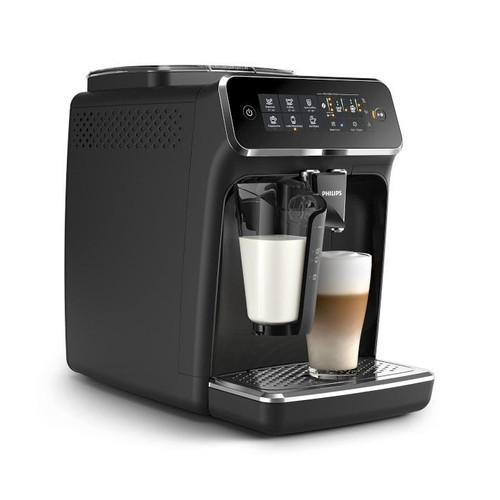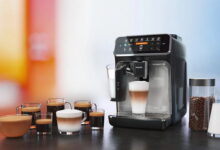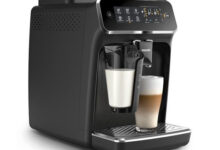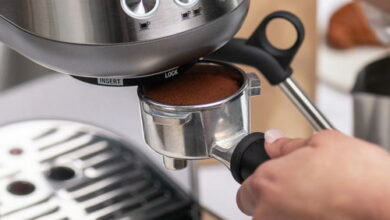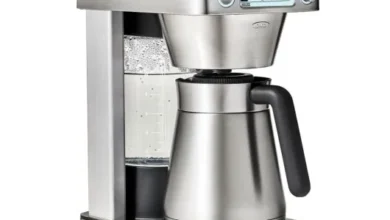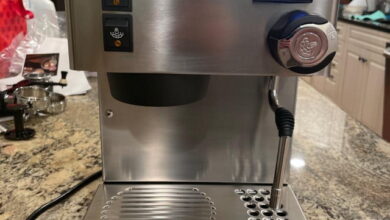When it comes to brewing the perfect cup of coffee at home, few machines stand out as much as the Philips LatteGo series. These machines promise to deliver café-quality coffee with minimal effort, combining innovative design with ease of use. In this guide, we’ll delve deep into the Philips LatteGo 3200 Series, offering detailed reviews and expert advice on how to maintain one of its standout features—the milk frother. Whether you’re a seasoned coffee enthusiast or a newcomer to home brewing, this guide will help you make the most of your Philips LatteGo.
Philips LatteGo 3200 Series Coffee Machine is the perfect blend of innovation and simplicity, designed to bring café-quality coffee to your home with just the touch of a button. Whether you’re an espresso aficionado or a latte lover, the Philips LatteGo 3200 series offers a versatile range of coffee options tailored to suit every taste. With its intuitive interface, customizable settings, and a revolutionary milk frothing system, this machine has quickly become a favorite among coffee enthusiasts who appreciate both convenience and quality. In this guide, we’ll explore the key features, offer troubleshooting tips, and provide essential maintenance advice to ensure your Philips LatteGo remains a reliable and cherished part of your daily routine.
Philips LatteGo Espresso Machine stands out not just for its performance, but also for its ease of use and maintenance. From detailed reviews of the 3200 series to a comprehensive comparison with other leading models, such as the Saeco PicoBaristo, this guide will help you make informed decisions about your coffee-making experience. Whether you’re considering investing in a new coffee machine or seeking tips to optimize the one you already own, the insights provided here will equip you with the knowledge you need to enjoy consistently great coffee at home.
Philips LatteGo 3200 Series Coffee Machine Reviews
The Philips LatteGo 3200 series is often hailed as one of the best mid-range coffee machines for home use. With its sleek design, intuitive controls, and versatile brewing options, it’s no wonder that this machine has garnered positive reviews from users around the world. But does it live up to the hype? Let’s take a closer look at what makes the Philips LatteGo 3200 series a standout choice.
Overview of the Philips LatteGo 3200 Series
The Philips LatteGo 3200 series is designed with convenience and quality in mind. One of the most significant features of this machine is the LatteGo milk system, which allows you to prepare lattes and cappuccinos with a silky froth in a matter of seconds. The machine also offers five different coffee options, including espresso, coffee, Americano, cappuccino, and latte macchiato, catering to a wide range of preferences.
The LatteGo 3200 series comes equipped with a ceramic grinder that ensures consistent grinding and a long lifespan. Additionally, the machine’s Aroma Extract system optimizes the brewing process by balancing temperature and aroma extraction, resulting in a rich and flavorful cup of coffee every time.
Detailed Analysis of Features and Performance
**1. Ease of Use: The Philips LatteGo 3200 series is designed for simplicity. The user interface features a clear, touch-sensitive display that makes it easy to select your desired coffee. With just a few taps, you can customize your brew’s strength, temperature, and volume. The intuitive design ensures that even those new to coffee machines can operate it without any hassle.
**2. Customizability: One of the standout features of the Philips LatteGo 3200 series is its level of customization. Users can adjust the grind size, coffee strength, and milk froth level to suit their taste preferences. This flexibility is particularly appealing to those who enjoy experimenting with different coffee styles and flavors.
**3. Milk Frothing System: The LatteGo milk system is a game-changer. Unlike traditional steam wands, the LatteGo system is fully automated, requiring no manual intervention. The system froths milk to a perfect consistency and delivers it directly into your cup. It’s incredibly easy to use and clean, making it ideal for those who love milk-based drinks but don’t want the hassle of a traditional frothing system.
**4. Build Quality and Design: The Philips LatteGo 3200 series features a modern, compact design that fits well in most kitchen spaces. The machine is constructed from high-quality materials, ensuring durability and longevity. The water reservoir and bean hopper are easily accessible, and the machine’s sleek appearance adds a touch of elegance to any countertop.
**5. Maintenance: One of the most significant advantages of the Philips LatteGo 3200 series is its ease of maintenance. The machine features a fully removable brewing unit, making it easy to clean. Additionally, the LatteGo milk system has just two parts, which can be rinsed under running water or placed in the dishwasher. The machine also features automatic descaling and cleaning programs, ensuring it stays in top condition with minimal effort.
User Reviews and Ratings
User feedback on the Philips LatteGo 3200 series has been overwhelmingly positive. Many users praise the machine’s ease of use, particularly the intuitive interface and automated milk frothing system. The customizable settings have also been well-received, allowing users to tailor their coffee to their exact preferences.
However, some users have noted that the machine can be somewhat noisy during the grinding process. Additionally, while the milk frother is convenient, it may not produce the ultra-fine microfoam preferred by some latte art enthusiasts.
Overall, the Philips LatteGo 3200 series has received high ratings for its performance, design, and ease of use. It’s a popular choice among those looking for a reliable and versatile coffee machine that delivers excellent results with minimal effort.
Pros and Cons Based on User Experiences
Pros:
- Intuitive and user-friendly interface.
- Versatile brewing options with customizable settings.
- Automated LatteGo milk frothing system.
- Compact design that fits well in most kitchens.
- Easy to clean and maintain.
Cons:
- The grinder can be noisy during operation.
- Milk froth may not meet the expectations of professional baristas.
- Higher price point compared to entry-level machines.
Final Verdict: Is the 3200 Series Worth the Investment?
The Philips LatteGo 3200 series is an excellent choice for those seeking a high-quality, versatile coffee machine that’s easy to use and maintain. While it may not be the cheapest option on the market, its combination of features, build quality, and performance make it a worthwhile investment for coffee lovers. If you’re looking for a machine that can deliver café-quality coffee at home with minimal effort, the Philips LatteGo 3200 series is definitely worth considering.
How to Clean Philips LatteGo Milk Frother
One of the standout features of the Philips LatteGo series is its innovative milk frothing system. However, to keep it functioning optimally and ensure your coffee always tastes fresh, it’s crucial to clean the milk frother regularly. In this section, we’ll provide a comprehensive guide on how to clean the Philips LatteGo milk frother, along with some tips to maintain it in top condition.
Importance of Keeping the Milk Frother Clean
The milk frother is one of the most critical components of the Philips LatteGo machine, especially for those who enjoy lattes, cappuccinos, and other milk-based beverages. Over time, milk residues can build up in the frother, leading to bacterial growth, unpleasant odors, and compromised coffee quality. Regular cleaning not only ensures that your drinks taste great but also prolongs the life of your machine and prevents potential health hazards.
Step-by-Step Guide on How to Clean the Philips LatteGo Milk Frother
Cleaning the Philips LatteGo milk frother is a straightforward process, thanks to its simple design. Here’s a step-by-step guide to help you keep it in pristine condition:
Step 1: Disassemble the Milk Frother
- Start by turning off the machine and unplugging it from the power source.
- Carefully remove the milk container from the machine.
- Detach the upper lid and milk spout from the container. These components come apart easily, with no tools required.
Step 2: Rinse the Parts
- Rinse the milk container, lid, and spout under warm running water. Make sure to remove any visible milk residues. The parts can also be placed in the dishwasher, as they are dishwasher-safe. Use the top rack of the dishwasher to avoid any potential damage from higher heat.
Step 3: Clean the Milk Tubes
- The Philips LatteGo milk frother has a short milk tube that connects the milk container to the spout. Ensure that this tube is thoroughly cleaned by flushing warm water through it. You can use a small brush or a specialized tube cleaner if needed.
Step 4: Wipe Down the Machine
- Use a damp cloth to wipe down the exterior of the machine, paying particular attention to the area around the milk frother attachment. This helps prevent any milk splashes from drying and becoming harder to clean later.
Step 5: Reassemble the Milk Frother
- Once all parts are thoroughly cleaned and dried, reassemble the milk frother. Ensure that the components are securely fitted to avoid any leaks during use.
Step 6: Perform a Rinse Cycle
- To ensure that no cleaning agents or milk residues remain, run a hot water cycle through the milk frother. This can usually be done by selecting the hot water option on your machine and allowing it to run through the milk frothing system.
Tips for Maintaining the Frother for Long-Term Use
To keep your Philips LatteGo milk frother in top condition, follow these additional maintenance tips:
- Clean After Every Use: Make it a habit to clean the milk frother immediately after each use. This prevents milk from drying and hardening inside the frother, making it easier to clean and ensuring better hygiene.
- Use Fresh Milk: Using fresh, cold milk can help prevent the buildup of residues in the frother. Avoid using milk that’s close to its expiration date or that has been sitting out for too long.
- Descale Regularly: In addition to cleaning the frother, it’s essential to descale your machine regularly. This helps remove mineral deposits that can affect the machine’s performance and the quality of the milk froth.
- Inspect the Frother Components: Periodically check the frother components for any signs of wear and tear. If you notice any cracks or damage, replace the parts promptly to avoid leaks or compromised performance.
- Store in a Cool, Dry Place: If you won’t be using the machine for an extended period, make sure to clean the milk frother thoroughly and store it in a cool, dry place. This prevents any residual moisture from causing mold or mildew growth.
Common Mistakes to Avoid During Cleaning
While cleaning the Philips LatteGo milk frother is straightforward, there are a few common mistakes that users should avoid:
- Using Abrasive Cleaners: Avoid using abrasive sponges or harsh cleaning agents on the milk frother components. These can scratch or damage the surfaces, affecting both the appearance and performance of the frother.
- Ignoring the Milk Tubes: Some users forget to clean the milk tubes, leading to a buildup of milk residues that can clog the system and affect the quality of the froth. Always ensure that the tubes are thoroughly rinsed after each use.
- Not Drying Components Properly: After cleaning, make sure all components are completely dry before reassembling the frother. Moisture can lead to bacterial growth or cause the milk frother to malfunction.
Troubleshooting Common Cleaning Issues
Despite regular cleaning, you may occasionally encounter issues with your Philips LatteGo milk frother. Here are some common problems and how to troubleshoot them:
- Weak or No Froth: If the froth is weak or non-existent, it could be due to a clog in the milk tubes or frother spout. Disassemble the frother and clean all parts thoroughly, paying special attention to the tubes.
- Milk Leaking from Frother: Leaks can occur if the frother components are not properly assembled or if the seals are worn out. Check that all parts are correctly fitted and replace any damaged seals.
- Unpleasant Odors: If you notice a sour or unpleasant smell, it could be due to milk residues that were not properly cleaned. Disassemble the frother and soak the parts in a mild vinegar solution, then rinse thoroughly to remove any lingering odors.
The Philips LatteGo 3200 series offers a perfect blend of convenience, customization, and quality, making it a top choice for home coffee enthusiasts. With regular maintenance and proper cleaning, particularly of the milk frother, this machine can consistently deliver café-quality coffee right in the comfort of your home. By following the steps and tips outlined in this guide, you’ll be able to enjoy delicious lattes and cappuccinos, all while keeping your Philips LatteGo in pristine condition.
Philips LatteGo Espresso Machine Troubleshooting
Even with the best coffee machines, occasional issues can arise. The Philips LatteGo is no exception, though its design minimizes common problems. Knowing how to troubleshoot your machine will ensure it continues to deliver excellent coffee without interruption. Here, we’ll cover the most common issues and how to resolve them quickly.
Common Issues Users Face with Philips LatteGo Espresso Machines
- Machine Not Turning On:
- Problem: The machine won’t power on, even when plugged in.
- Solution: First, check if the machine is properly plugged into the power outlet. Ensure the outlet is functional by testing it with another device. If the outlet is working, check the machine’s power cord for any signs of damage. If everything seems fine, the internal fuse may have blown, in which case you should contact Philips customer support.
- Water Leakage:
- Problem: Water leaks from the machine, either from the water reservoir or during the brewing process.
- Solution: Check if the water reservoir is securely placed in the machine. Leaks can also occur if the reservoir is cracked or damaged, so inspect it for any signs of wear. If the leak happens during brewing, it could be due to a clogged or misaligned brewing unit. In this case, remove and clean the brewing unit thoroughly, ensuring it’s correctly reinserted.
- Coffee Not Dispensing Properly:
- Problem: The machine dispenses little or no coffee, or the flow is interrupted.
- Solution: This could be due to a clogged coffee spout or a blockage in the brewing unit. Clean the coffee spout and the brewing unit thoroughly. If the problem persists, it might be due to an issue with the grinder settings. Try adjusting the grind size to see if it improves the flow. Regular descaling can also prevent this issue by keeping the internal components free of mineral buildup.
- Weak or Bitter Coffee:
- Problem: The coffee tastes weak or unusually bitter.
- Solution: Weak coffee can result from using too coarse a grind setting or too little coffee. Adjust the grind size to a finer setting and increase the coffee strength in the machine’s settings. Bitter coffee, on the other hand, might be due to over-extraction, which can occur if the grind is too fine or if the water temperature is too high. Adjust the settings accordingly and make sure to clean the brewing unit to remove any old coffee residues that could affect the taste.
- Noisy Grinder:
- Problem: The grinder is louder than usual during operation.
- Solution: A noisy grinder might indicate that it’s working too hard due to a buildup of coffee grounds or debris. Clean the grinder regularly to ensure it operates smoothly. If the noise persists, it might be due to wear on the grinder’s burrs, which would require professional servicing or replacement.
How to Reset the Machine and When to Contact Customer Support
If you encounter persistent issues that don’t resolve with basic troubleshooting, resetting your Philips LatteGo machine can often help. To reset the machine:
- Turn off the machine and unplug it from the power source.
- Wait for about 10 minutes before plugging it back in.
- Turn the machine back on and see if the issue persists.
If resetting the machine doesn’t solve the problem, or if you’re dealing with more serious issues like electrical faults or internal damage, it’s best to contact Philips customer support. They can provide further assistance or arrange for the machine to be serviced.
Preventive Measures to Avoid Common Problems
Preventing issues with your Philips LatteGo machine is always better than troubleshooting them later. Here are some preventive measures to keep your machine running smoothly:
- Regular Cleaning:
- Clean the brewing unit, milk frother, and coffee spout regularly to prevent clogs and ensure optimal performance.
- Descale Periodically:
- Descale your machine according to the manufacturer’s instructions to prevent mineral buildup that can affect both the taste of your coffee and the machine’s performance.
- Use Fresh, High-Quality Beans:
- Use fresh, high-quality coffee beans to reduce the chances of clogging and to ensure a better-tasting cup of coffee. Store beans in an airtight container to preserve their freshness.
- Avoid Overloading the Grinder:
- Don’t overload the grinder with too many beans at once. This can cause the machine to work harder and result in a noisier operation.
By following these preventive measures, you can avoid most common issues and keep your Philips LatteGo machine in top condition for years to come.
Best Settings for Philips LatteGo Coffee Machine
One of the key attractions of the Philips LatteGo series is its high level of customizability. The machine allows users to fine-tune various settings to create their perfect cup of coffee, whether it’s a strong espresso or a creamy latte. In this section, we’ll explore the best settings for different types of coffee and how to adjust them to suit your personal taste.
Overview of Customizable Settings
The Philips LatteGo coffee machine offers several customizable settings, including:
- Coffee Strength: Adjust the intensity of the coffee by increasing or decreasing the amount of coffee used per cup.
- Grind Size: Fine-tune the grind size to control the extraction rate and flavor profile.
- Temperature: Set the brewing temperature to suit different types of coffee beans.
- Milk Froth Level: Customize the amount and texture of milk froth for lattes and cappuccinos.
Recommended Settings for Different Types of Coffee
- Espresso:
- Strength: High
- Grind Size: Fine
- Temperature: Medium-High
- Milk Froth: None
Tip: For a rich and intense espresso, use a finer grind and a high strength setting. This ensures maximum flavor extraction. If you prefer a slightly cooler espresso, lower the temperature setting.
- Americano:
- Strength: Medium
- Grind Size: Medium
- Temperature: High
- Milk Froth: None
Tip: An Americano is essentially an espresso diluted with hot water. Use a medium strength setting and a medium grind size for a balanced flavor. The higher temperature ensures the added water doesn’t cool down the drink too much.
- Cappuccino:
- Strength: Medium-High
- Grind Size: Medium-Fine
- Temperature: Medium
- Milk Froth: High
Tip: For a cappuccino, use a medium-fine grind size to ensure a strong coffee flavor that pairs well with the milk froth. Adjust the milk froth level to create a dense, creamy foam.
- Latte Macchiato:
- Strength: Medium
- Grind Size: Medium
- Temperature: Medium-Low
- Milk Froth: Medium-High
Tip: A latte macchiato should have a subtle coffee flavor with a lot of milk. Use a medium grind size and a medium strength setting, but focus on getting the right amount of milk froth to achieve the classic layered look.
How to Adjust Settings to Match Personal Taste Preferences
The Philips LatteGo machine’s settings are designed to be easily adjustable, allowing you to experiment with different combinations to find your perfect brew. Here’s how to adjust them:
- Coffee Strength:
- Increase the strength for a more intense flavor, or decrease it for a milder taste. This can be done through the machine’s touch interface, where you can select from several strength levels.
- Grind Size:
- Adjust the grind size by turning the knob inside the bean hopper. A finer grind will produce a stronger coffee, while a coarser grind will result in a lighter brew.
- Temperature:
- The temperature setting can be adjusted through the machine’s menu. Choose a higher temperature for darker roasts and a lower temperature for lighter roasts or more delicate beans.
- Milk Froth Level:
- Customize the milk froth level using the machine’s froth adjustment settings. A higher froth level is ideal for cappuccinos, while a lower level is better suited for lattes.
Tips for Experimenting with Settings to Achieve the Perfect Brew
- Start with the Recommended Settings: Begin by using the recommended settings for each type of coffee, then adjust gradually based on your preferences.
- Keep a Coffee Journal: Note down the settings you use for each brew, along with your impressions. This will help you refine your preferences over time.
- Don’t Be Afraid to Experiment: Try different combinations of strength, grind size, and temperature to discover new flavors and textures.
By experimenting with these settings, you can unlock a wide range of coffee experiences with your Philips LatteGo machine, making every cup uniquely yours.
Common Mistakes When Adjusting Settings and How to Fix Them
- Over-Tamping the Coffee Grounds:
- Problem: If you use too fine a grind or pack the coffee grounds too tightly, it can lead to over-extraction and a bitter taste.
- Solution: Adjust to a coarser grind size and ensure the coffee grounds are evenly distributed without excessive tamping.
- Inconsistent Milk Froth:
- Problem: The milk froth might be too airy or too dense, depending on the milk type and froth settings.
- Solution: Experiment with different milk types (whole, skim, or plant-based) and adjust the froth level to achieve your desired consistency.
- Incorrect Temperature Setting:
- Problem: Coffee that is too hot can scald the milk or result in over-extraction, while too low a temperature might lead to under-extraction.
- Solution: Use the recommended temperature settings for different coffee types and adjust based on the roast profile of your beans.
By avoiding these common mistakes and fine-tuning your settings, you can consistently achieve the perfect brew with your Philips LatteGo machine.
Philips LatteGo vs Saeco PicoBaristo Comparison
With so many coffee machines on the market, it’s essential to know how the Philips LatteGo compares to other popular models. The Saeco PicoBaristo is another highly regarded coffee machine, often compared to the Philips LatteGo. In this section, we’ll take a closer look at how these two machines stack up against each other.
Brief Introduction to Both Machines
Philips LatteGo 3200 Series:
- Designed for convenience and ease of use, the Philips LatteGo 3200 series features an automated milk frothing system, customizable settings, and a user-friendly interface. It’s ideal for those who want a versatile machine that delivers café-quality coffee at home.
Saeco PicoBaristo:
- The Saeco PicoBaristo is known for its compact design and high level of customization. It offers a wide range of coffee options, from espresso to milk-based drinks, and features a built-in milk frothing system. The PicoBaristo is favored by users who appreciate the ability to fine-tune their coffee to their exact preferences.
Feature Comparison: What Sets Each Machine Apart?
- Milk Frothing System:
- Philips LatteGo: The LatteGo features a fully automated milk frothing system that’s easy to clean and use, making it ideal for beginners.
- Saeco PicoBaristo: The PicoBaristo offers a more traditional milk frothing experience with a steam wand, giving users greater control over the texture and temperature of the milk.
- Customization Options:
- Philips LatteGo: Offers a good range of customization options, including coffee strength, grind size, and milk froth level.
- Saeco PicoBaristo: Provides even more customization, with the ability to adjust not only coffee strength and grind size but also pre-infusion settings and brew temperature.
- Ease of Use:
- Philips LatteGo: Extremely user-friendly, with a simple touch interface and pre-programmed coffee options.
- Saeco PicoBaristo: While also user-friendly, it offers more advanced features that might require a steeper learning curve.
Performance Comparison: Which Machine Delivers Better Coffee Quality?
Philips LatteGo:
- The LatteGo excels in delivering consistent, high-quality coffee with minimal effort. The automated milk frother ensures a perfect cappuccino or latte every time, though it might not satisfy those looking for a more personalized frothing experience.
Saeco PicoBaristo:
- The PicoBaristo is slightly more geared towards coffee connoisseurs who appreciate the ability to fine-tune their brew. Its steam wand allows for more precise control over milk frothing, making it ideal for those who enjoy creating latte art or experimenting with milk textures.
Ease of Use and Maintenance: Which Machine Is More User-Friendly?
Philips LatteGo:
- The LatteGo is designed for maximum convenience. Its intuitive interface and automated cleaning functions make it one of the easiest machines to use and maintain.
Saeco PicoBaristo:
- While the PicoBaristo is also easy to use, its additional customization options and manual steam wand mean it requires a bit more involvement from the user. Cleaning and maintenance are straightforward, but slightly more hands-on compared to the LatteGo.
Price Comparison and Value for Money: Which One Offers Better Value?
Philips LatteGo:
- The LatteGo typically comes at a lower price point than the Saeco PicoBaristo, making it an excellent value for those who want a high-quality machine without breaking the bank.
Saeco PicoBaristo:
- The PicoBaristo is priced higher, reflecting its additional features and customization options. It offers excellent value for coffee enthusiasts who want more control over their brew and are willing to invest in a more advanced machine.
Final Verdict: Which One Should You Choose?
Choosing between the Philips LatteGo and the Saeco PicoBaristo ultimately depends on your priorities. If you value ease of use, quick and consistent results, and minimal maintenance, the Philips LatteGo is the better choice. However, if you’re a coffee aficionado who enjoys experimenting with different brewing techniques and wants more control over every aspect of your coffee, the Saeco PicoBaristo might be worth the extra investment.
Philips LatteGo Replacement Parts and Accessories
Keeping your Philips LatteGo in top condition sometimes requires replacing certain parts or adding accessories that enhance your coffee-making experience. In this section, we’ll discuss the essential replacement parts and accessories for your Philips LatteGo machine.
List of Essential Replacement Parts for the Philips LatteGo
- Water Filters:
- Philips recommends replacing the water filter every two months to ensure the best water quality and prevent scale buildup. The AquaClean filter is specifically designed for Philips machines and is a must-have for maintaining your machine.
- Milk Frother Parts:
- The LatteGo’s milk frother consists of a few key parts, including the milk container, lid, and spout. These parts are easily replaceable if they become worn or damaged.
- Grinder Burrs:
- Over time, the ceramic grinder burrs may wear out, affecting the grind consistency. Replacing the burrs can restore the machine’s grinding performance and improve the flavor of your coffee.
- Drip Tray and Waste Container:
- The drip tray and waste container collect coffee residues and water, and they can become worn or cracked over time. Replacing these parts helps maintain cleanliness and prevents leaks.
Where to Buy Genuine Philips LatteGo Replacement Parts
It’s important to buy genuine Philips replacement parts to ensure compatibility and maintain the quality of your machine. Here are a few reliable sources:
- Philips Official Website:
- The Philips website offers a wide range of replacement parts and accessories, ensuring you get genuine products.
- Authorized Retailers:
- Many authorized retailers, both online and in physical stores, carry Philips replacement parts. Check with Philips to find an authorized retailer near you.
- Online Marketplaces:
- Online marketplaces like Amazon often have Philips parts available, but be sure to purchase from a reputable seller to avoid counterfeit products.
Recommended Accessories to Enhance Your Coffee Experience
- Descaling Solution:
- Regular descaling is essential for maintaining your machine’s performance. Philips offers a descaling solution specifically formulated for their machines.
- Coffee Grinder:
- While the Philips LatteGo has a built-in grinder, having a separate coffee grinder allows you to experiment with different grind sizes and bean types.
- Knock Box:
- A knock box is a convenient accessory for disposing of used coffee grounds. It keeps your workspace clean and makes it easier to prepare multiple cups of coffee in a row.
- Milk Frothing Jug:
- If you want to practice latte art or manually control your milk frothing, a separate milk frothing jug is a great addition.
Tips for Ensuring Compatibility When Purchasing Parts and Accessories
- Check the Model Number:
- Always check your machine’s model number to ensure you’re purchasing compatible parts. Philips often provides compatibility information on their website or in the product manual.
- Buy from Authorized Sellers:
- To avoid counterfeit parts, purchase from authorized sellers or directly from Philips.
- Read Reviews:
- Before buying parts or accessories, read customer reviews to ensure they meet your expectations in terms of quality and performance.
How to Replace Parts and Perform Basic Maintenance on Your Machine
Replacing parts on the Philips LatteGo is straightforward, thanks to its user-friendly design. Here’s a general guide on how to replace common parts:
- Water Filter:
- Remove the old water filter from the water tank, insert the new filter, and follow the machine’s instructions to reset the filter counter.
- Milk Frother Parts:
- Disassemble the frother, remove the worn parts, and replace them with the new ones. Ensure all components are securely fitted before reassembling.
- Grinder Burrs:
- Access the grinder through the bean hopper, remove the old burrs, and install the new ones. It’s advisable to follow the detailed instructions in your machine’s manual for this process.
- Drip Tray and Waste Container:
- Simply slide out the old tray or container and replace it with the new one. Regular cleaning of these parts helps prolong their lifespan.
By keeping your machine in good working order and replacing worn parts as needed, you’ll enjoy consistently great coffee for years to come.
Conclusion
The Philips LatteGo series is a top-tier choice for coffee lovers who value convenience, customization, and quality. From understanding the nuances of the 3200 series to maintaining the milk frother and troubleshooting common issues, this guide provides all the information you need to get the most out of your machine.
Philips LatteGo 3200 Series Coffee Machine offers unparalleled convenience and quality, making it an excellent choice for those who want to enjoy barista-level coffee without the hassle. By following the tips and advice outlined in this guide, you can ensure that your Philips LatteGo continues to deliver delicious and satisfying coffee, day after day. From mastering the machine’s customizable settings to performing regular maintenance, this guide has everything you need to get the most out of your investment.
Philips LatteGo Espresso Machine is more than just a coffee maker; it’s a gateway to a better coffee experience at home. Whether you’re troubleshooting common issues or exploring ways to enhance your coffee routine, this guide provides the tools and knowledge to make every cup perfect. With the right care and attention, your Philips LatteGo will continue to be a reliable and cherished part of your kitchen, delivering café-quality coffee at the touch of a button.
Whether you’re experimenting with different settings, comparing it to other machines like the Saeco PicoBaristo, or looking for the best accessories and replacement parts, the Philips LatteGo delivers on its promise of bringing café-quality coffee into your home. With proper care and attention, your Philips LatteGo machine will continue to serve up delicious, barista-style coffee for years to come.
Frequently asked questions (FAQs) related to the Philips LatteGo coffee machine
- How do I clean the Philips LatteGo milk frother?
To clean the Philips LatteGo milk frother, disassemble the milk container, lid, and spout, then rinse them under warm water or place them in the dishwasher. Ensure the milk tubes are flushed with water, and reassemble after drying the parts.
- How often should I descale my Philips LatteGo coffee machine?
It’s recommended to descale the Philips LatteGo coffee machine every 3 months or when the machine alerts you to descale. This helps prevent mineral buildup and ensures optimal performance.
- Can I use non-dairy milk with the Philips LatteGo frother?
Yes, the Philips LatteGo frother works with non-dairy milks such as almond, soy, and oat milk. However, the froth consistency may vary depending on the type of milk used.
- How do I adjust the coffee strength on my Philips LatteGo machine?
You can adjust the coffee strength by using the touch interface on the machine. Select the coffee option you want to customize, then use the strength setting to increase or decrease the coffee intensity.
- Why is my Philips LatteGo not dispensing coffee properly?
If your Philips LatteGo isn’t dispensing coffee properly, it may be due to a clogged coffee spout or a blockage in the brewing unit. Cleaning these components usually resolves the issue.
- What should I do if my Philips LatteGo machine is leaking water?
If your machine is leaking water, check that the water reservoir is securely placed and inspect it for any cracks. If the leak occurs during brewing, clean the brewing unit and ensure it’s properly reassembled.
- How do I replace the water filter in my Philips LatteGo?
To replace the water filter, remove the old filter from the water tank, insert the new AquaClean filter, and reset the filter counter by following the instructions provided by the machine.
- Can I adjust the temperature of the coffee brewed by my Philips LatteGo?
Yes, you can adjust the temperature of your coffee through the machine’s menu settings. This allows you to customize the brew temperature to match different coffee beans and preferences.
- What is the difference between the Philips LatteGo 3200 series and other models?
The Philips LatteGo 3200 series is known for its ease of use, automated milk frothing system, and customizable coffee settings. It differs from other models like the 2200 or 4300 series in terms of additional features, price, and the number of coffee options available.
- How do I perform a factory reset on my Philips LatteGo coffee machine?
To perform a factory reset, turn off the machine, unplug it, and wait for about 10 minutes. Plug it back in and turn it on. If issues persist, consult the user manual or contact Philips customer support for assistance.

